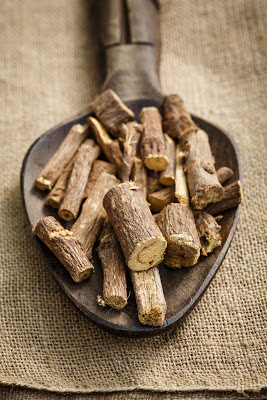When thinking of licorice most of us think of it as the main ingredient in candy and beverages, but this sweet root has a long history noted for its medicinal benefits. The use of wild licorice in North America as medicine begins with Native Americans. They used every part of this plant in an impressive list of applications.
Medicinal Uses
American Licorice was widely used by the Native Americans throughout the country. A common use of this plant was to make a medicinal tea from the peeled dry roots to treat an upset stomach or diarrhea.
The Cheyenne, Montana Indians and Northwestern Tribes ate the tender spring shoots raw. The Lakota's used the root of the plant as a medicine for the flu and the Dakota's steeped licorice leaves in boiling water to make a topical medicine for an earache. The Blackfeet made a tea from the root to relieve coughs, chest pain, and sore throat.
Wild licorice leaf poultices were an excellent remedy for sores on people and on horses. Young shoots of this plant also had a use, they were nibbled on to keep the mouth sweet and moist. Even burrs of this plant were used and were sucked on by Buffalo runners of the Black Foot Indians to keep from getting thirsty.
Wild Licorice Today
The way we use this plant today has its roots in the way it was used by Native Americans. Wild Licorice is high in anti-inflammatory flavonoids, free radical scavenging antioxidants, estrogen balancing isoflavones and soothing saponins. Today, many health food stores and online shops sell a variety of licorice extracts that can be used for a variety of ailments. One of the most popular forms of the plant is licorice tea that is thought to promote digestive, respiratory and adrenal gland health.
About The Institute for American Indian Studies
The Institute for American Indian Studies preserves and educates through discovery and creativity the diverse traditions, vitality, and knowledge of Native American cultures. Through archaeology, the IAIS is able to build new understandings of the world and history of Native Americans, the focus is on stewardship and preservation. This is achieved through workshops, special events, and education for students of all ages.
Located on 15 woodland acres the IAIS has an outdoor Three Sisters and Healing Plants Gardens as well as a replicated 16th c. Algonkian Village. Inside the museum, authentic artifacts are displayed in permanent, semi-permanent and temporary exhibits from prehistory to the present that allows visitors a walk through time. The Institute for American Indian Studies is located on 38 Curtis Road in Washington Connecticut and can be reached online or by calling 860-868-0518.


No comments:
Post a Comment